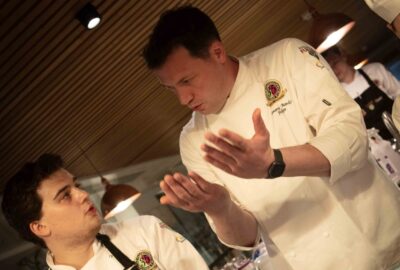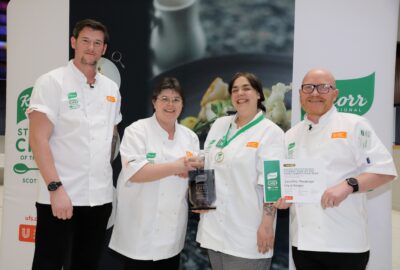Oh crumbs! With the new series of the BBC’s Great British Bake-off set to hit our screens later this month, the nation is set to fall in love with home-baking all over again – but would your baked offerings meet the approval of Mary Berry and Paul Hollywood?
Here, eight brilliant bakers offer their top tips…
Chetna Makan, semi finalist in the GBBO 2014 www.chetnamakan.co.uk
My tip for a light and lovely cake is to use ingredients at room temperature. If you have forgotten to take the butter out of the fridge the night before then warm it up in the microwave for few seconds before using. Also whisking is key, don’t underestimate the importance of the time you put into whisking the cake batter. The mix turns light and pale and you know then that you have whisked enough. Once you have mastered the basic sponge you can play with the flavours by adding different fruits or nuts or spices. It’s good to experiment but first thing is to get the basics right. Also do a little research to find out which spices match which fruits and then you can get experimenting.
My experience in the bake-off tent was amazing and I got to learn so much from the other bakers. Out of all the many things I learnt the most helpful thing was when you are making Italian meringue buttercream and when you reach the stage of adding the butter to the meringue and it splits (which it does often and happened to me in the tent). Don’t panic because all you need to do is to continue to whisk and slowly, in a few minutes, it will become creamy and smooth. So never throw away the buttercream thinking that it is spilt – instead just keep whisking.
Candice Bannister, owner of Candy’s Cupcakes in Manchester www.candyscupcakes.co.uk and creator of the cake on our front cover
The vintage look is very much on trend at the moment and people are favouring “naked cakes” such as Victoria Sponges decorated with fresh fruit and flowers. Bunting made from icing and sugar paste roses are also very popular on a range of celebration cakes, harking back to the 1940s vintage style.
- To create your own sugar roses: First make a cone 1-3cm long out of sugar paste then make nine circles about the size of a two pence piece. Wrap the first circle around the tip of the cone, then a row of three overlapping on top of that. Finally add the remaining five, again overlapping, and curl back one corner of each circle to create a petal.
Charlotte Bailey, sales manager for Orchard Valley Foods www.orchard-valley.co.uk and www.secret-ingredients.com
When caterers come to decide how to add the finishing touches to their offering, we see them reach for a core set of decorations which can work in a range of applications. Whether they are decorating an ancient grain-based flapjack slice, topping a cupcake, or creating a spring themed ice cream sundae, it helps to have a range of products that can work across the board.
A lemon yellow crunch that can be baked in to a batter mix for a lemon drizzle cake, as well as being used to decorate a doughnut, and also finishing a lemon macaroon tart, is going to prove its worth in a caterers store cupboard. We’ve had really good feedback on the versatility of our Secret Ingredients Professional Range, which includes for example caramel fudge cubes that can be baked in to a cranberry and fudge flapjack, or used to top a chocolate mousse, or to fill the centre of a retro inspired giant jammy dodger.
Dean Edwards, celebrity chef and Bacofoil brand ambassador
Hybrids are a huge trend in the baking world at the moment, pairing two styles of cake or dessert together to develop one delicious creation. Examples are cronuts (croissant and donut), wafer cookies, pie pops and a recipe I recently created for Bacofoil, Baked Rhubarb Brûlée Cheesecake – a twist on a classic cheesecake.
- Unlike the majority of recipes, baking recipes cannot just be thrown together. Take time to weigh out your ingredients carefully, as the ratios of fats to flours can be critical to your final result.
- To give your baking more chance of success, eggs should be room temperature before using and always use the specified size of tin in the recipe. Using a tin that’s too large can cause your baking to dry out, but using a tin that’s too small can cause your baking to cook unevenly.
- Cool your cake upside down. This will flatten out the top of the cake, creating easy-to-stack disks for layer cakes. If the top of a cake is too rounded, just slice it off with a knife.
You can find Dean’s recipe for his Baked Rhubarb Brûlée Cheesecake on the Stir it up website.
Ben Purton, executive chef at Lancaster London www.lancasterlondon.com
With Afternoon Tea, choosing a theme is a key thing, whether this is around something that you do well, a certain time of the year, an important date or something that’s just special to the guest. Gluten-free requests are more frequent than ever so you need to have a good selection.
I am a traditional three-tier man myself and I love the look of a fully-loaded stand. Present just enough that the plates will take and refresh/refill as needed. I always present the stand with the scones initially missing (they are still in the oven) as this just adds to the show and something held back is always a good bet.
Frances Quinn, winner of the 2013 GBBO, author of ‘Quinntessential Baking’, and judge at the forthcoming Tiptree World Bread Awards www.worldbreadawards.com
Apart from the bread tasting better and adding a personal touch to the caterer and menu, you know exactly what’s gone into freshly made bread and can cater the bread to suit different occasions and seasons.
Weighing your ingredients is always key, but equally flours can absorb liquid differently, so being aware that you may need to add more or less water etc is important.
Mixing sweet and savoury flavours can add interest as can using different types of salts and herbs. Pairing the bread with unusual seasoned butters can also becoming a talking point. From Marmite marled to a miso inspired one, especially delicious if the bread contains an element of seaweed/lava.
Sourdough and gluten free breads are obviously very popular as are using sprouted grains and mixing flours such as spelt and buckwheat into the mix.
See Country Club for your chance to win one of two signed copies of Frances’ new book.
Mark Rigby, executive chef at Premier Foods
- Put an original twist on the traditional arctic roll by flavouring the ice cream filling; why not try amaretto ice cream for an adult option.
- Enrich your lemon meringue pie with a little melted butter and lemon zest in the filling and a touch of ground ginger in the pastry.
- Why not make your crumbles seasonal; using apples and pears in winter, then rhubarb in spring, moving through to apricots and gooseberries in summer then blackberries in the autumn.
- The trend for cupcakes is still going strong and consumers are always on the look-out for new and innovative flavours; try salted caramel in your butter icing or Earl Grey tea in your sponge cake. You can also experiment with textures and flavours in your icing; try mixing in Italian meringue, marshmallow or cream cheese.
- If you are catering for someone who requires a texture-modified dish, you don’t have to make a separate meal. By following a few simple procedures, caterers can modify desserts such as Black Forest gâteau and pineapple upside down cake to ensure they are safe for those suffering with dysphagia.
Phil Vickery, top chef and gluten-free expert. Phil has teamed up with Knorr for a series of gluten-free masterclasses
When Knorr asked chefs which gluten-free recipes they want to see more of, cakes topped the list (66%), with baked goods following shortly behind (60%). Breads and pies were also popular choices.
My top tip for gluten-free baking? Be very accurate when measuring out the ingredients. Also, when using gluten-free flour, make sure you mix it thoroughly when you take it out of the packet. Some ingredients in the flour mix are heavier than others, which can affect the end result.
I’m passionate about improving understanding among chefs and operators on the need for more gluten-free cooking. Together with Knorr, we’re hoping to dispel the myth it’s difficult to create gluten-free food that tastes great! It can be a lot simpler than you think. Rather than treating gluten-free food as separate dishes only suitable for coeliacs, we want to get chefs thinking ‘gluten-free, so what?’ and creating meals that are delicious enough for everyone to enjoy.


